Typhoo Tea DO YOU KNOW?
Issued in 1962 in the UK, the DO YOU KNOW? 24-card set of Typhoo tea cards explores a series of interesting topics like culture, nature, astronomy, insects, animals and more. The front of each card features a photo relating to the question at hand, and the back of the card contains a brief answer to the question. Typhoo’s tea cards were used as reference guides like mini-encyclopedic articles and quickly became collector’s items.

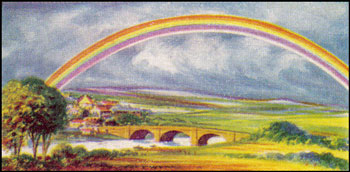
No. 1 WHAT CAUSES A RAINBOW?
A rainbow is caused by the refraction (bending) and reflection of sunlight in minute drops of water in the air. This has the effect of splitting up light into its seven constituent colours. It may be seen when standing with one’s back to the sun and facing a rain shower on which the sun is shining.
No. 2 WHY WE SHAKE HANDS?
This very old custom may have originated when men carried a sword and the right or weapon hand was offered to friends as a sign of trust and good will. Also, in feudal times, the vassal placed his hands in those of his overlord when taking the oath of fidelity.

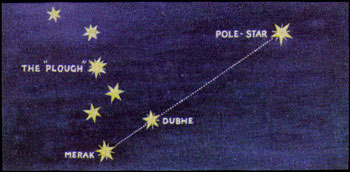
No. 3 HOW TO FIND THE POLE STAR?
As the Pole Star is seldom more than about one degree from due north, it has been an invaluable guide to seamen through the ages. The easily recognizable group of stars which form “The Plough” include the two stars “Merack” and “Dubhe” which, as shown, point almost directly to the Pole Star.
No. 4 HOW PEARLS ARE FORMED?
Pearls are produced by some shelled mollusks, notably the oyster, whose inner surface is covered with “Mother of Pearl”. When a foreign body such as a parasite or a grain of sand causes an irritation, the oyster secretes a substance round it which then solidifies to form a pearl.


No.5 WHAT IS A VOLCANIC ERUPTION?
Volcanoes occur when gas pressures in the inner core of the earth build up and seek to escape through fractures in the outer crust of the earth’s surface. Pressures are so great that vapour, cinders and ashes are thrown high in the air and rocks and molten lava are discharged.
No.6 WHO BUILT THE PYRAMIDS?
These vast and impressive structures on the west bank of the Nile were built by the Pharaohs, Kings of ancient Egypt, as royal tombs. They date back to about 3000 B.C. According to Herodotus, the Greek historian, it took 300,000 men about twenty years to build the Great Pyramid of Cheops.

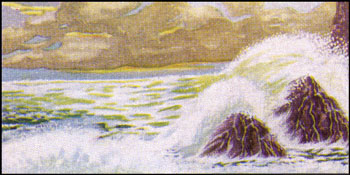
No.7 WHAT CAUSES THE WAVES?
The wind disturbs the surface of the sea and the moving swell is called a wave. Waves vary greatly in size and character according to the intensity and type of wind. The white foamy crests are due to the presence of salt in the sea water.
No.8 WHY SIRLOIN IS SO NAMED?
The word “sirloin” is derived from the French word “sur-longe”, meaning above the loin, and should really be spelt “surloin”. The misspelling has given rise to many stories regarding the origin of the word, the most popular being that Henry VIII knighted a loin of beef for its excellence.
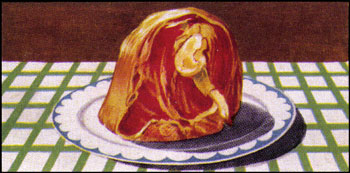

No.9 WHAT CAUSES LIGHTNING?
A flash of lightning is caused by the intense heat of a discharge of electricity between two clouds or between a cloud and the earth during a storm. Thunderstorms are produced by powerful rising currents of air within clouds and usually occur during hot summer afternoons or evenings.
No.10 MUSHROOMS FROM TOADSTOOLS?
The edible mushroom grows only in open pastures and has a white or brown-white cap and gills which are white when young, then pink, brown or black. The poisonous Death-cap toadstool grows in woods and nearby pastures and has an olive-green cap and crowded white gills sometimes tinged with green.
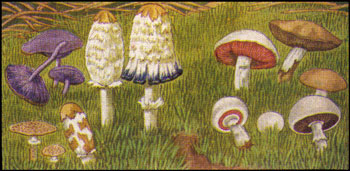

No.11 WHY BULLS ARE RINGED?
When man started keeping cows and bulls in farms, the problem was to find a method of controlling the wild and aggressive male. It was found that a bull’s nose is very sensitive and that by ringing it and attaching a stick to the ring, the animal could be handled with safety.
No.12 WHAT THE LETTERS ON A FISHING BOAT MEAN?
All British fishing boats are registered at one or other of main fishing ports such as Grimsby or Aberdeen. This was made compulsory by the Merchant Shipping Act passed in 1894. The letters indicate the port of registration and the numbers are those under which the individual boats are recorded.
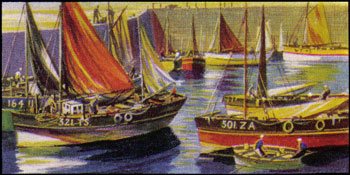
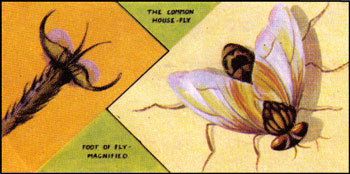
No.13 HOW DOES A FLY WALK UPSIDE-DOWN?
The House Fly or “Musca domestica” is able to walk up upside-down on the ceiling or up and down on a slippery pain of glass. This is because the last joints on its legs are provided with cushion-like pads covered with minute hairs which secrete a sticky fluid.
No.14 WHAT SHOOTING STARS ARE?
These are not whole stars but solid fragments of stars called meteors, which hurtle down towards the earth at immense speed, the friction of the air making them hot and luminous. The heat usually changes them to gas or dust, but some reach the earth and are then called meteorites.


No.15 WHAT CAUSES OAK APPLES?
The familiar oak apples are actually abnormal structures and are not part of a healthy oak tree. They are caused by Gall-wasps (Cynips) which lay their eggs in dormant buds during the winter. The grubs which emerge set up an irritation and a rapid growth of these swellings or galls occurs.
No.16 WHY AN IRON SHIP FLOATS?
A ship displaces from the space it occupies a weight of water equal to its own weight and an iron ship is no exception. This follows the well known law of Archimedes. The science of modern ship building is still based on the same principle and iron has proved a practical and durable material.
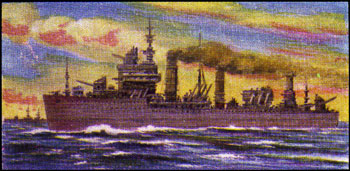
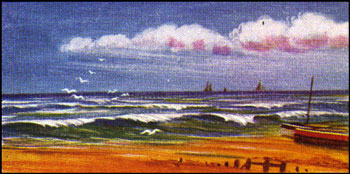
No.17 HOW THE SAND COMES TO THE SEA SHORE?
Sand consists mainly of quartz and tiny pieces of shell. Sand found on the sea shore derives in part from the breaking down of cliffs by the action of the wind and waves. Inland rocks are also worn down by weathering and some sand is brought to the sea by rivers.
No.18 WHY WATER RUNS OFF A DUCK’S BACK?
The feathers of all birds, but more especially of aquatic birds, are set very closely together to form a warm, waterproof coating. The oil glands also play an important part in keeping the feathers dry. Ducks spend a great deal of time in grooming their plumage, each feather being preened individually.
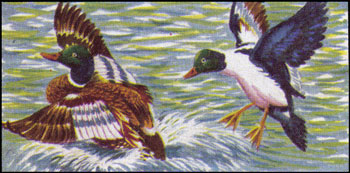

No.19 WHAT IS A MIRAGE?
A mirage is an optical illusion sometimes seen in desert regions and caused by unequal heating of the various parts of the atmosphere which bends the light rays and produces distorted images. Palm trees and dwellings, often many miles from their actual position, seem reflected in water.
No.20 HOW A VACUUM FLASK KEEPS ITS HEAT?
The vacuum flask was invented by Sir James Dewar (1842-1923). It consists of a glass vessel with double walls between which is a vacuum for airless space. A hot liquid normally loses heat by radiation to the air around it and if this is excluded the liquid remains hot.


No.21 HOW A SPIDER’S WEB IS FORMED?
The spider possesses a set of glands which secrete a viscid fluid through minute tubes at the end of the abdomen. This fluid has the extraordinary property of hardening on exposure to the air and with it the spider is able to spin intricate webs for the capture of insects.
No.22 WHY COINS HAVE MILLED EDGES?
In the days when coins were hand made and had irregular edges, dishonest people used the file to clip off shavings of gold and silver. During the reign of Charles II (1660-1685) a powerful screw mill which produced regular edges came into standard use.
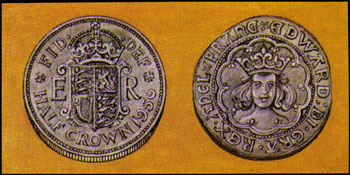

No.23 WHAT CAUSES FOG?
Particles of condensed water vapour or smoke in the surface layers of the atmosphere produce the phenomenon we recognise as fog. This is sometimes caused by the air near the ground being cooled by radiation on a still, clear night or by flowing over a cold mass of water.
No.24 HOW OUR NATIONAL FLAG WAS FORMED?
The original Union Jack was adopted in 1606 by order of James I and consisted of the cross of St. Andrew and the cross of St. George. When, in 1801, the Irish Parliament was dissolved and the Act of Union came into force, the Arms of Fitzgerald (cross of St. Patrick) were incorporated.

